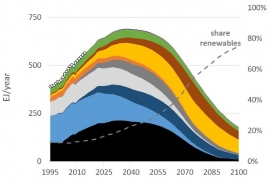GEEDS-UVa team has just published a scientific article in the Energy & Environmental Science Journal, entitled: "MEDEAS: a new modeling framework integrating global biophysical and socioeconomic constraints". This paper reports results from MEDEAS WP4 and describes the methodology of the MEDEAS models which were developed during the project at global (MEDEAS-W), European Union (MEDEAS-EU) and country-level models (MEDEAS-Austria and MEDEAS-Bulgaria).
MEDEAS is a pioneering modelling framework in various aspects. It has been designed to facilitate the evaluation of energy transition policies, with a novel approach that integrates biophysical, economic, social and technological constraints. The MEDEAS models are a bridge between Ecological Economics and Post-Keynesian Economics and apply novel assumptions that try to correct weaknesses present in most of the integrated assessment models: the poor integration - lack of feedbacks - between submodules, the predominance of artificial optimization and equilibrium approaches to resolve the allocation of resources, the assumption of abundance of energy resources (both fossil and renewable), the omission of material and energy investments related to the transition to renewables and the lack of coherence of the impacts expected from climate change by the natural sciences.
MEDEAS models address these deficiencies through a detailed sectoral economic structure based on input-output analysis (representation of interdependence between different economic sectors) within a system dynamics approach rich in dynamic feedbacks. Both the availability of energy and the impacts of climate change feed back in the model and can become limiting factors in the economic process. MEDEAS models also study the effect of mineral limitations on the energy transition and estimates the net energy available to society through the concept of the dynamic energy return on energy Invested (EROI). Another of the characteristics of the MEDEAS models is its flexibility and transparency, which reach levels that are rare in the scientific literature. Both MEDEAS-W and MEDEAS-EU can be freely downloaded from the project website. There is also a free online course with videos and tutorials explaining the model and how to use it.
These characteristics, together with a detailed description of the methodology used to design the models, is what is described in the academic publication that we present in this post. This publication, therefore, does not present scenarios with alternative policy proposals for sustainability, but only results on the current main dynamics and the effect of feedbacks. For this, a central scenario of continuation of tendencies has been simulated in which the energy restrictions and the feedback of climate change are functional and three other auxiliary scenarios in which these restrictions are sequentially deactivated in order to see their influence on the results. The figure at the end of the post shows a selection of results in the four scenarios in terms of energy consumption, GDP per capita, the effects of technological improvement, as well as greenhouse gas emissions and average temperature increase.
Our results show that the continuation of current trends will lead in the future to an “explosive cocktail” of energy shortages (initiated by peak oil) and impacts of climate change that we think without a profound change in the currently dominant social priorities and economic system will most likely lead to scenarios of regionalization, conflict, and ultimately global crisis, leading to the collapse of our modern civilization. Due to the complexity of the topic and the difficulty of compressing it into a dissemination post, we refer to the original publication and the online course for more detailed explanations of these results.
MEDEAS models continue to be developed under the ongoing h2020 LOCOMOTION project.

Reference to the article
Capellán-Pérez, I., Blas, I. de, Nieto, J., Castro, C. de, Miguel, L.J., Carpintero, Ó., Mediavilla, M., Lobejón, L.F., Ferreras-Alonso, N., Rodrigo, P., Frechoso, F., Álvarez-Antelo, D., 2020. MEDEAS: a new modeling framework integrating global biophysical and socioeconomic constraints. Energy & Environmental Science. https://doi.org/10.1039/C9EE02627D

